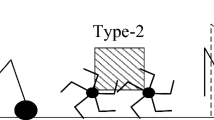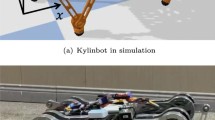Abstract
This study investigates local stability of a four-link limit cycle walking biped with flat feet and compliant ankle joints. Local stability represents the behavior along the solution trajectory between Poincare sections, which can provide detailed information about the evolution of disturbances. The effects of ankle stiffness and foot structure on local stability are studied. In addition, we apply a control strategy based on local stability analysis to the limit cycle walker. Control is applied only in the phases with poor local stability. Simulation results show that the energy consumption is reduced without sacrificing disturbance rejection ability. This study may be helpful in motion control of limit cycle bipedal walking robots with flat feet and ankle stiffness and understanding of human walking principles.













Similar content being viewed by others
References
Collins S, Wisse M, Ruina A (2001) A three-dimensional passive-dynamic walking robot with two legs and knees. Int J Robot Res 20:607–615
Collins S, Ruina A, Tedrake R, Wisse M (2005) Efficient bipedal robots based on passive-dynamic walkers. Science 307:1082–1085
Frigo C, Crenna P, Jensen LM (1996) Moment-angle relationship at lower limb joints during human walking at different velocities. J Electromyogr Kinesiol 6(3):177–190
Goswami A, Thuilot B, Espiau B (1998) A study of the passive gait of a compass-like biped robot: symmetry and chaos. Int J Robot Res 17:1282–1301
Goswami A, Espiau B, Keramane A (1996) Limit cycles and their stability in a passive bipedal gait. In: Proceedings of IEEE International Conference on Robotics and Automation, Minneapolis, USA
Hirai K, Hirose M, Haikawa Y, Takenaka T (1998) The development of the Honda Humanoid robot. In: Proceedings of the IEEE International Conference on Robotics and Automation, Leuven, Belgium, pp 1321–1326
Hobbelen DGE, Wisse M (2007) Limit cycle walking, humanoid robots: human-like machines, pp 277–294
Hobbelen DGE, Wisse M (2008) Ankle actuation for limit cycle walkers. Int J Robot Res 27(6):709–736
Hosoda K, Takuma T, Nakamoto A, Hayashi S (2008) Biped robot design powered by antagonistic pneumatic actuators for multi-modal locomotion. Robot Auton Syst 56:46–53
Huang Y, Wang Q (2016) Torque-stiffness-controlled dynamic walking: analysis of the behaviors of bipeds with both adaptable joint torque and joint stiffness. IEEE Robot Autom Mag 23(1):71–82
Huang Q, Yokoi K, Kajita S, Kaneko K et al (2001) Planning walking patterns for a biped robot. IEEE Trans Robot Autom 17(3):280–289
Huang Y, Vanderborght B, Van Ham R, Wang Q et al (2013) Step length and velocity control of a dynamic bipedal walking robot with adaptable compliant joints. IEEE/ASME Trans Mechatron 18:598–611
Huang Y, Vanderborght B, Van Ham R, Wang Q (2014) Torque-stiffness-controlled dynamic walking with central pattern generators. Biol Cybern 108:803–823
Huang Y, Huang Q, Wang Q (2017) Chaos and bifurcation control of torque-stiffness-controlled dynamic bipedal walking. IEEE Trans Syst Man Cybern Syst 47(7):1229–1240
Huang Y, Wang Q, Chen B, Xie G, Wang L (2012) Modeling and gait selection of passivity-based seven-link bipeds with dynamic series of walking phases. Robotica, vol. 30, pp 39–51
Hubicki C, Grimes J, Jones M et al (2016) ATRIAS: design and validation of a tether-free 3D-capable spring-mass bipedal robot. Int J Robot Res 35(12):1497–1521
Hurmuzlu Y, Moskowitz GD (1986) Role of impact in the stability of bipedal locomotion. Int J Dyn Stab Syst 1(3):217–234
Hyon SH, Suewaka D, Torii Y, Oku N (2017) Design and experimental evaluation of a fast torque-controlled hydraulic humanoid robot. IEEE/ASME Trans Mechatron 22(2):623–634
Iida F, Rummel J, Seyfarth A (2008) Bipedal walking and running with spring-like biarticular muscles. J Biomech 41:656–667
Kaneko K, Kanehiro F, Kajita S (2004) Humanoid robot HRP-2. In: Proceedings of the IEEE International Conference on Robotics and Automation, New Orleans, LA, USA, pp 1083–1090
Kuo AD (2002) Energetics of actively powered locomotion using the simplest walking model. J Biomech Eng 124:113–120
Kuo AD (2005) Harvesting energy by improving the economy of human walking. Science 309:1686–1687
Kwan M, Hubbard M (2007) Optimal foot shape for a passive dynamic biped. J Theor Biol 248:331–339
McGeer T (1990) Passive dynamic walking. Int J Robot Res 9(2):62–82
Meng L, Macleod CA, Porr B, Gollee H (2018) Bipedal robotic walking control derived from analysis of human locomotion. Biol Cybern 112:277–290
Mombaur KD (2001) Stability optimization of open-loop controlled walking robots, PhD thesis, Heidelberg University, Ruperto Carola
Norris JA, Marsh AP, Granata KP, Ross SD (2008) Revisiting stability of 2D passive biped walking: local behavior. Physica D 237(23):3038–3045
Reher J, Ames AD (2021) Inverse dynamics control of compliant hybrid zero dynamic walking, In: Proceedings of IEEE International Conference on Robotics and Automation, Xian, China, pp 2040–2047
Saccon A, van de Wouw N, Nijmeijer H (2014) Sensitivity analysis of hybrid systems with state jumps with application to trajectory tracking. In: Proceedings IEEE Conference on Decision and Control (CDC), pp 3065–3070
Sharbafi MA, Seyfarth A (2015) FMCH: a new model for human-like postural control in walking, In: Proceedings of IEEE international conference on intelligent robots and systems, Hamburg, Germany, pp 5742–5747
Shiriaev AS, Freidovich LB, Gusev SV (2010) Transverse linearization for controlled mechanical systems with several passive degrees of freedom. IEEE Trans Automat Contr 55(4):893–906
Spong MW, Holm JK, Lee D (2007) Passivity-based control of bipedal locomotion. IEEE Robot Autom Mag 14(2):30–40
Tsagarakis NG, Morfey S, Medrano-Cerda GA et al (2013) Compliant humanoid COMAN: optimal joint stiffness tuning for modal frequency control. IEEE International Conference on Robotics Automation, Karlsruhe, Germany, pp 673–678
Van Ham R, Vanderborght B, Van Damme M, Verrelst B, Lefeber D (2007) MACCEPA, the mechanically adjustable compliance and controllable equilibrium position actuator: design and implementation in a biped robot. Robot Auton Sys 55:761–768
Vanderborght B, Verrelst B, Van Ham R, Van Damme M et al (2006) Exploiting natural dynamics to reduce energy consumption by controlling the compliance of soft actuators. Int J Robot Res 25:343–358
Wang Q, Huang Y, Wang L (2010) Passive dynamic walking with flat feet and ankle compliance. Robotica 28:413–425
Wisse M, Schwab AL, van der Helm FCT (2004) Passive dynamic walking model with upper body. Robotica 22:681–688
Acknowledgements
This work was supported by the National Natural Science Foundation of China (Nos. 62073038 and 51922015) and also supported by the Beijing Institute of Technology Research Funds for High-Level Talents.
Author information
Authors and Affiliations
Contributions
Y.H. and Q.W. wrote the main manuscript text. Y.H. and Y.G. prepared the simulations and experiments. Q.W. and Q.H. supervised the study. All authors reviewed the manuscript.
Corresponding author
Ethics declarations
Conflict of interest
The authors declare no conflicts of interest.
Additional information
Communicated by Jordi Garcia-Ojalvo.
Publisher's Note
Springer Nature remains neutral with regard to jurisdictional claims in published maps and institutional affiliations.
Rights and permissions
Springer Nature or its licensor (e.g. a society or other partner) holds exclusive rights to this article under a publishing agreement with the author(s) or other rightsholder(s); author self-archiving of the accepted manuscript version of this article is solely governed by the terms of such publishing agreement and applicable law.
About this article
Cite this article
Huang, Y., Gao, Y., Huang, Q. et al. Controlling flat-foot limit cycle walkers with compliant joints based on local stability variation. Biol Cybern 118, 111–126 (2024). https://doi.org/10.1007/s00422-024-00987-y
Received:
Accepted:
Published:
Issue Date:
DOI: https://doi.org/10.1007/s00422-024-00987-y




